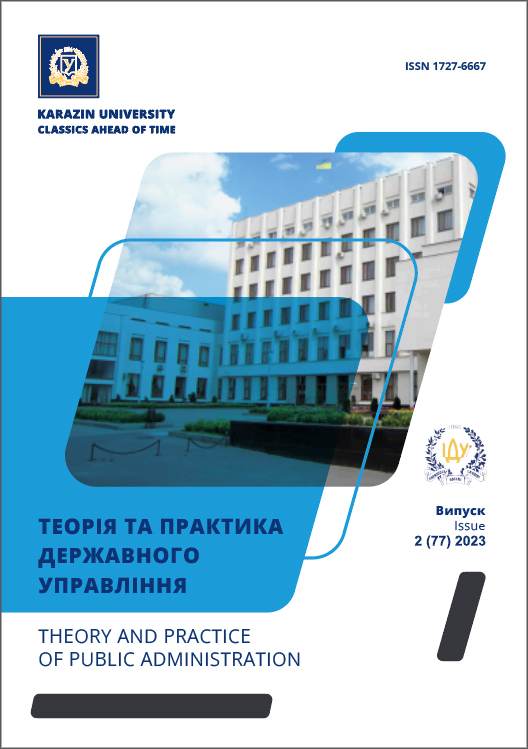Specific Activities of Public Authority Bodies in Emergency and Crisis Situations
Abstract
This article is devoted to consideration of the peculiarities of the activities of public authorities in emergency and crisis situations. It was determined that crisis and emergency management is a cyclical process. The various stages include assessment, planning, preparation, mitigation, response, transition to recovery and final assessment; and careful evaluation and consideration of lessons learned can increase sustainability in the future. It is noted that there is no zero risk in any activity. No matter how marginal it may be, there is always some degree of risk involved. Every activity we do in life involves risk, and the difference is that we accept those risks after a cost-benefit or rational choice analysis and assign them relative priorities.
It is emphasized that as soon as a threat manifests itself or a critical incident exceeds the capabilities or resources of the organization, there is a need to respond. The guiding principles of this process are developed at the planning and preparation stage of the crisis and disaster management cycle. This includes public-private partnerships as well as working with alternative stakeholders such as non-governmental organizations, charities, voluntary groups and the public. Effective provision of such interaction is possible through the use of the so-called C7 Doctrine.
The elements of an effective response to the crisis were identified: maintaining reputational integrity; smart planning and preparedness; strong leadership; effective and timely communications; strategic, well-organized interdepartmental cooperation; strategic allocation of resources; successful operational tactics; post-crisis assessment and learning to improve on any mistakes made along the way. It has also been established that during a critical incident or crisis event, there are two main requirements for their resolution: an organization that must respond adequately, and a leader who directs the efforts of this organization.
Downloads
References
Andreev, S.O. (2008). The organizational and legal mechanism of state management of civil protection at the regional level: shortcomings and ways to eliminate them. Actual problems of public administration, 2 (34), 418 – 427 [in Ukrainian].
Barylo, O.H., Poteryaiko, S.P., & Tyshchenko, V.O. (2011). Evaluation of the effectiveness of the organization of public administration in emergency situations. Scientific Bulletin of the Academy of Municipal Management, 2, 56–60 [in Ukrainian].
Belousov, A.V. (2013). The role of the modern state in preventing and eliminating the consequences of emergency situations. Investments: practice and experience, 20, 153–156. [in Ukrainian].
Vovchenko, S.D. (2013). Development of the theoretical foundations of the functioning of the system of protection of the population and territories against emergency situations. Economy and the state, 10, 141–144 [in Ukrainian].
Volyansky, P.B. (2013). Methodological approaches to risk management in the process of eliminating the consequences of emergency situations. Investments: practice and experience, 13, 134–136 [in Ukrainian].
Dzyundzyuk, V.B., & Polkovnychenko, D.Yu. (2013). The influence of emergency situations on the socio-economic development of territories. State building, 2. Retrieved from: http://nbuv.gov.ua/UJRN/DeBu_2013_2_11 (accessed 15 October 2023)
[in Ukrainian].
Klymenko, N.G. (2008). Peculiarities of public administration in emergency situations: theoretical and historical aspects (dissertation for obtaining a PhD in public administration: specialty 25.00.01 «Theory and History of Public Administration»). Kyiv: NADU [in Ukrainian].
Kuznichenko, S.O. (2002). State administration in the field of man-made and natural safety. Actual problems of public administration, 2 (13), Ch. ІІ, 287–290 [in Ukrainian].
Melnychenko, O.A. (2014). State emergency management mechanisms: essence and components. State construction, 1. Retrieved from: http://nbuv.gov.ua/UJRN/DeBu_2014_1_11 (accessed 15 October 2023) [in Ukrainian].
Polkovnychenko, D.Yu. (2014). Geoinformation system for providing territory management in emergency situations. Investment practice and experience, 23, 145–148. [in Ukrainian].
Polkovnychenko, D.Yu. (2014). Components of management in emergency situations. Theory and practice of public administration, 4 (47), 423–430 [in Ukrainian].
Polkovnychenko, D.Yu. (2014). Formation of public opinion in managing the development of territories in emergency situations. Investment practice and experience,
, 171–174 [in Ukrainian].
Trush, O.O., & Koshkin A.O. (2013). Systems of preparation for decision-making by state administration bodies in emergency situations (incidents). Theory and practice of public administration, 4, 256–262 [in Ukrainian].
Boin, A., t’Hart, P., Stern, E., & Sundelius B. (2006). The Politics of Crisis Management: Public leadership under pressure. Cambridge: Cambridge University Press [in English].
El-Tawil, S., & Aguirre, B. (2010). Search and rescue in collapsed structures: Engineering and social science aspects. Disasters, 34(4), 1084-1101 [in English].
Fink, S. (2013). Crisis Communications: The Definitive Guide to Managing the Message. New York: McGraw-Hill Education [in English].
International Organization for Standardization (2018). ISO 3100-2:2018 Risk Management Guidelines. Geneva: ISO [in English].
Kates, R. (1985). Perilous Progress. Managing the Hazards of Technology. Hohenemser: Boulder [in English].
Munera, H. (1987). Quantitative comparison of natural and technological societal risks. Geneva: GPSR [in English].
Pursiainen, C. (2018). The Crisis Management Cycle. Oxon: Routledge [in English].
Quarantelli, E.L. (1985). Organizational Behavior in Disasters and Implications for Disaster Planning. Newark, DE: Disaster Research Center [in English].
Copyright (c) 2023 Theory and Practice of Public Administration

This work is licensed under a Creative Commons Attribution 4.0 International License.
Authors who publish with this journal agree to the following terms:
- Authors retain copyright and grant the journal right of first publication with the work simultaneously licensed under a Creative Commons Attribution License that allows others to share the work with an acknowledgement of the work's authorship and initial publication in this journal.
- Authors are able to enter into separate, additional contractual arrangements for the non-exclusive distribution of the journal's published version of the work (e.g., post it to an institutional repository or publish it in a book), with an acknowledgement of its initial publication in this journal.
- Authors are permitted and encouraged to post their work online (e.g., in institutional repositories or on their website) prior to and during the submission process, as it can lead to productive exchanges, as well as earlier and greater citation of published work (See The Effect of Open Access).

